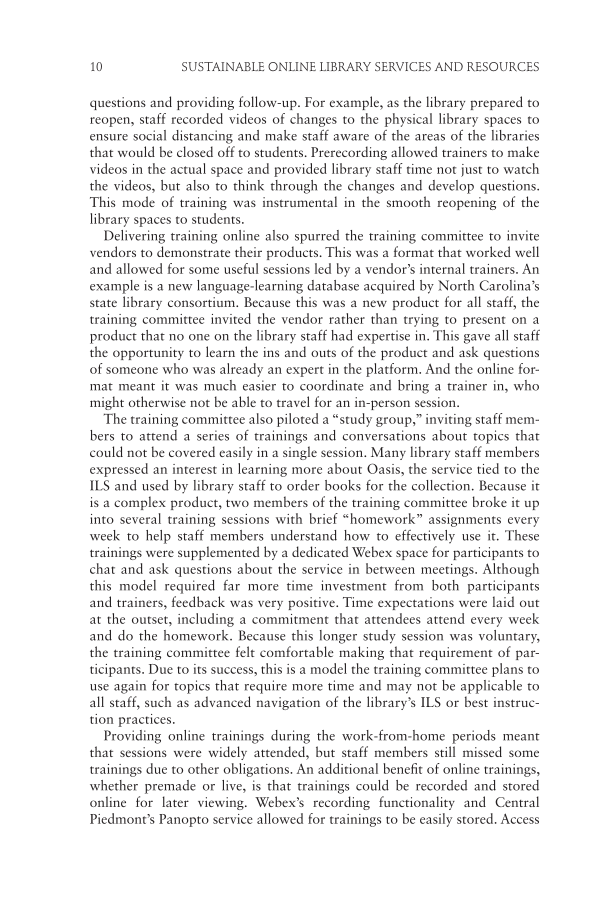10 SUSTAINABLE ONLINE LIBRARY SERVICES AND RESOURCES questions and providing follow-up. For example, as the library prepared to reopen, staff recorded videos of changes to the physical library spaces to ensure social distancing and make staff aware of the areas of the libraries that would be closed off to students. Prerecording allowed trainers to make videos in the actual space and provided library staff time not just to watch the videos, but also to think through the changes and develop questions. This mode of training was instrumental in the smooth reopening of the library spaces to students. Delivering training online also spurred the training committee to invite vendors to demonstrate their products. This was a format that worked well and allowed for some useful sessions led by a vendor’s internal trainers. An example is a new language-learning database acquired by North Carolina’s state library consortium. Because this was a new product for all staff, the training committee invited the vendor rather than trying to present on a product that no one on the library staff had expertise in. This gave all staff the opportunity to learn the ins and outs of the product and ask questions of someone who was already an expert in the platform. And the online for- mat meant it was much easier to coordinate and bring a trainer in, who might otherwise not be able to travel for an in-person session. The training committee also piloted a “study group,” inviting staff mem- bers to attend a series of trainings and conversations about topics that could not be covered easily in a single session. Many library staff members expressed an interest in learning more about Oasis, the service tied to the ILS and used by library staff to order books for the collection. Because it is a complex product, two members of the training committee broke it up into several training sessions with brief “homework” assignments every week to help staff members understand how to effectively use it. These trainings were supplemented by a dedicated Webex space for participants to chat and ask questions about the service in between meetings. Although this model required far more time investment from both participants and trainers, feedback was very positive. Time expectations were laid out at the outset, including a commitment that attendees attend every week and do the homework. Because this longer study session was voluntary, the training committee felt comfortable making that requirement of par- ticipants. Due to its success, this is a model the training committee plans to use again for topics that require more time and may not be applicable to all staff, such as advanced navigation of the library’s ILS or best instruc- tion practices. Providing online trainings during the work-from-home periods meant that sessions were widely attended, but staff members still missed some trainings due to other obligations. An additional benefit of online trainings, whether premade or live, is that trainings could be recorded and stored online for later viewing. Webex’s recording functionality and Central Piedmont’s Panopto service allowed for trainings to be easily stored. Access
Document Details My Account Print multiple pages
Print
You have printed 0 times in the last 24 hours.
Your print count will reset on at .
You may print 0 more time(s) before then.
You may print a maximum of 0 pages at a time.













































































































































































































































































